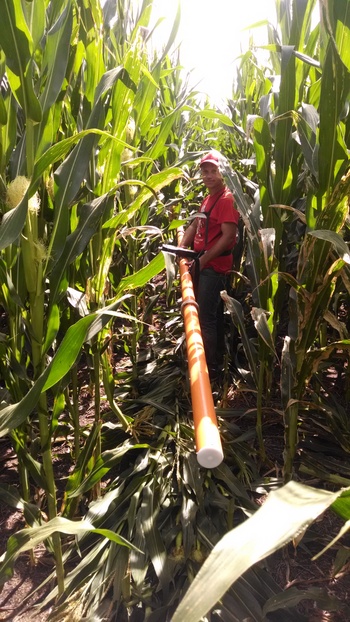UW engineer models groundwater to help farmers at home and abroad
Argentina might seem a long way to go for an environmental engineer seeking to better understand land use in Wisconsin. But there are some surprising parallels between the two countries’ histories of land use and ecohydrology.

Steve Loheide with geophysical equipment on San Claudio Farm, owned by the University of Buenos Aires. Courtesy Steve Loheide.
Take, for example, the lowland Pampas region, which extends across southeastern Argentina, all of neighboring Uruguay, and a bit of southern Brazil. People associate the area with images of cattle grazing in fertile pastures, but in the past few decades, the area’s farmers have increasingly turned to corn, soybean and other row crops — a trend that sounds familiar to Wisconsin residents.
In 2014, those similarities inspired Civil and Environmental Engineering Associate Professor Steve Loheide to travel to Argentina on a grant from the Fulbright Scholar Program. He gained insights about computer modeling tools that could now help farmers and officials make groundwater decisions to benefit both agriculture and natural ecosystems.
For Loheide, the crucial question is what happens below the surface when natural and managed ecosystems exert different influences on groundwater. “The main thing that I’m looking at is the lateral exchanges of groundwater between ecosystems,” says Loheide, who is also affiliated with the UW–Madison Geological Engineering Program, Freshwater and Marine Sciences program and the Gaylord Nelson Institute for Environmental Studies. “We live in an increasingly human-dominated landscape, in which we have patches of managed land with remnant ecosystems interspersed.”
Loheide and his collaborators at the Universidad Nacional de San Luis looked at areas in the Pampas and Chaco regions of Argentina where patches of forest have been converted into corn farms. The corn’s roots run shallower than those of forest trees, which means water percolating downward has more of a chance to recharge the groundwater below, and to potentially “subsidize” neighboring forest areas’ water supply providing the ecosystem with a backup groundwater supply in a period of drought. Conversely, if too much groundwater builds up, this could eventually cause a lack of oxygen in the soil and kill the crops.
“What’s really interesting is the interplay between natural ecosystems and managed ecosystems, and what balance of those provides us with the highest level of ecosystem services — crop yield, clean water and healthy ecosystems,” Loheide says.
Drawing on field data gathered by Argentine researcher Esteban Jobaggy, Loheide has built models to simulate groundwater transfer between cropland and neighboring natural ecosystems. Loheide says that ultimately, decision-makers can use the model results to predict future shortages and excesses of groundwater in cropland. They can then optimize management strategies, such as planting new forests and all manner of variations in what farmers plant and when.
“This group has been doing fieldwork about these ecosystems for the last 15 years,” says Loheide. “I can now transfer that knowledge into a model to ask, ‘Can we really predict how this system functions?’ And then we have a predictive framework for decision-making — what if we convert 10 percent of the landscape? What if we convert 90 percent? How do those two choices differ?”
As he prepares for his return to Madison, Loheide says the Fulbright experience, which aims to stimulate international cooperation through scholarship, has given him a broader view that will greatly benefit his future research and teaching.
“Investigating soils, climates and management practices in a range of environments is key to parsing out the individual influence of each controlling factor,” says Loheide. “We study systems with some contrasting characteristics — the climate of Wisconsin versus that of Argentina for example — to help us build confidence in our models. This is critical in our ever-changing world because the conditions we find in the Wisconsin of today may not be the same for generations to come.”
Enjoy this story?
Read more news from the College of EngineeringSubscribe to Wisconsin Ideas
Want more stories of the Wisconsin Idea in action? Sign-up for our monthly e-newsletter highlighting how Badgers are taking their education and research beyond the boundaries of the classroom to improve lives.
